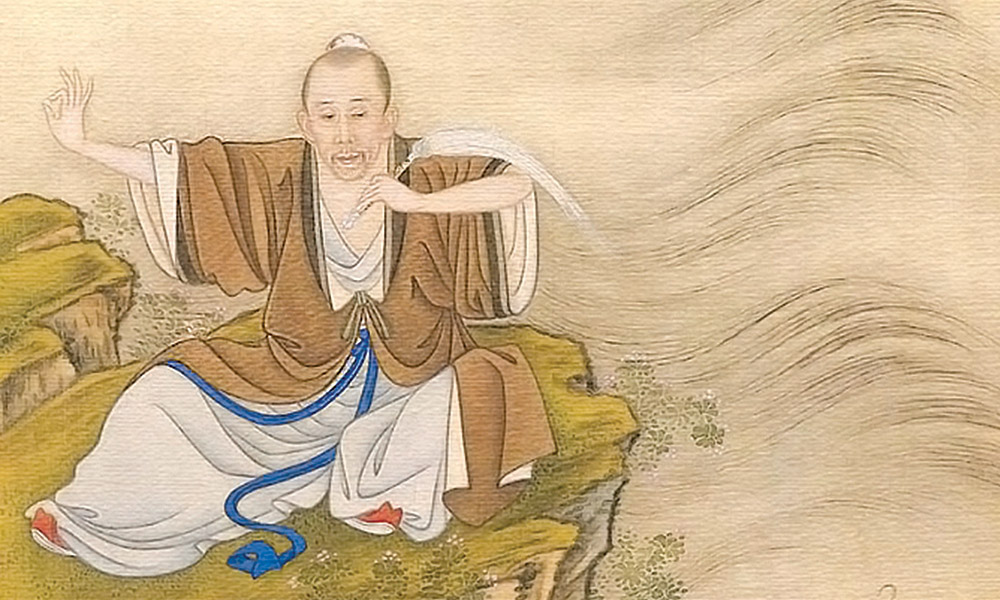By Vibrant Dot Staff
Many of us have heard of the Chinese martial art Taiji Quan (太极拳), or more colloquially known as Taiji or Tai Chi (太极). But few of us know about its founder Zhang Sanfeng (张三丰).
A legendary Taoist in Chinese history, the elusive Zhang was said to have attained the Tao and immortality. Historical records say he lived over 200 years through three dynasties: the Southern Song, Yuan and Ming.
Many legends abound of Zhang’s incredible exploits and supernatural powers. But let’s begin in the year 1247 A.D., with the magical birth of this cultural hero.
The Path to Taoist Immortality
According to the History of Ming, Zhang Sanfeng was born in today’s Fuxin, Liaoning province. Legend goes that on the night of his birth, Zhang’s mother dreamed of a deity calling upon an immortal crane. The crane landed on the roof of her home and called out three times, startling her into wakefulness.
Later that night, she gave birth to a boy, whom they named Zhang Quanyi.
When Zhang was five years old, he developed a strange illness that gradually robbed him of his eyesight. But he was noticed by a Taoist priest, Zhang Yun-An. “Your son has extraordinary innate qualities for Taoist cultivation,” Yun-An told the worried parents. “But evil spirits are causing him to lose his sight. Let me teach him the Tao, and I will bring him back when his eyesight has recovered.”
Zhang’s parents agreed, and Zhang left home to train with the Taoist priest. Gifted with a photographic memory, Zhang very quickly learnt the classics in Taoism, Confucianism, and Buddhism. Within half a year, he had regained his eyesight, but he decided to stay for seven more years before returning to his parents.
As an adult, Zhang passed the imperial examinations and became a county magistrate. But when he was 32, his parents passed away and Zhang resigned to mourn them.
The deaths of Zhang’s parents must have had a profound impact on him, for instead of returning to civil service, Zhang set off on a journey to seek the Tao. For the next three decades, his efforts seemed futile – he travelled to various legendary mountains across China, but found no answers.
Finally at age 67, Zhang met the legendary Taoist Huolong Zhen Ren (火龙真人, or ‘Fire Dragon’) in the Zhongnan Mountains. There, he learnt the essentials of internal cultivation and alchemy. He gave himself the Taoist name Zhang Sanfeng (three peaks), after the three mountain peaks in Baoji, Shaanxi Province where he dwelled for several years.
Another 10 years was to pass before Zhang arrived at Wudang Mountain—where he practiced the Tao for nine consecutive years before finally attaining enlightenment.
The Birth of Tai Chi
After wandering for several years, Zhang Sanfeng finally settled in the Wudang Mountains, where he developed the Wudang School of internal martial arts.
Chinese martial arts originate from the Buddhist and Taoist cultivation methods. They can mainly be classified into two schools: Shaolin and Wudang, which are popular in south and north China respectively.
The internal martial arts of the Wudang School, known as The Neijia, were founded by Zhang. Wudang stresses internal strength, with an emphasis on using softness to conquer strength, and calmness over hastiness. This is consistent with the philosophy of Taoism—quietness, softness, weakness, detachment, and inaction. Its comprehensive methods include Taiji Quan (“Supreme Ultimate Fist”) and Wuxing Quan (“Five Elements Fist”), among many others.
Some anecdotes say that Zhang drew inspiration from watching a snake being attacked by a bird. While the bird flapped and clawed haphazardly at the snake, the snake remained still and alert in the face of the onslaught, eventually lunging and delivering a fatal bite.
By merging martial arts with internal cultivation methods such as qi-leading and breathing methods, Zhang transformed traditional, external martial arts into an internal practice that enabled health improvement and Tao cultivation. Not only could they be used for self-defence, they could also prolong one’s life.
But more importantly, Zhang’s Tai-Chi was not just about exercising the body, but about improving one’s mind and moral character. Without cultivating the mind, the Tai Chi exercises alone are not enough to better the body.
What Was Zhang Sanfeng Like?
Historical records describe Zhang as a peculiar man. He was tall and sturdy, with a turtle-shaped back and a long beard. Even in the coldest winters or the hottest summers, he always wore the same thing: a Taoist robe and a straw rain cape.

Zhang’s mystic abilities included consuming as much as 50 kilograms of food in one sitting, or going without food for months. He could recite a scripture after reading it only once, and could travel thousands of miles in a single day. He often surprised people by sleeping in the snow in winter. Above all, he was light-hearted and humorous, without a care of what others thought of him.
The internal martial arts of the Wudang School, known as The Neijia, were founded by Zhang.
One place where we can find many hallowed legends of Zhang is Jintai Temple in the Baoji Mountains, where Zhang spent many years practicing the Tao.
The temple grounds contain an ancient Ming Dynasty plaque, titled “A Remaining Record of Zhang Sanfeng”. Erected by the Ming official Zhang Yongwan, it narrates his father’s personal encounter with Zhang Sanfeng.
When Yongwan’s father, Chaoyong, was 13, his father Zhang Wei brought the family to Jintai Temple to escape from war. One day, a wandering Zhang Sanfeng met Chaoyong at the temple.
Upon learning who Chaoyong’s father was, Zhang sighed, “I was well acquainted with your ancestor Zhang Rong when I was in Zhecheng County. Now tell me, in what way are you related to Zhang Yi?”
Chaoyong replied that Zhang Yi was his grandfather. Zhang Sanfeng sighed, “Ah, Zhang Yi was still a child when I last saw him.” He then encouraged Chaoyong to study hard, as he could eventually become a third-rank official (this did become a reality).
After staying for a month, Zhang left the temple and Chaoyong went to send him off. To the astonishment of everyone present, Zhang walked away without his feet touching the ground.
According to the History of Ming, Zhang’s soul once left his body for seven days while he was at Jintai Temple. Zhang had predicted his own death, and before passing he composed and sang a hymn. But on the day of his burial, Zhang came back to life. Upon his return, he prophesised to his disciple Yang Gui that the Ming Dynasty would topple the Yuan Dynasty.
The Miraculous Do-Gooder
After attaining immortality, Zhang was said to exercise unimaginable power. However, he continued to roam the human world, using his powers to restrain the bad and promote the good.
In the Ming Dynasty text ‘Casual Writings of the Clear Stream’, Zhang once saved the lives of an official and his family, using his straw cape and bamboo cap.
The hospitable Li Jinglong once hosted Zhang Sanfeng in his home for several days. On the last day of his stay, Zhang told Li, “In less than a thousand days, disaster will befall your household, and you’ll be faced with a period of starvation. But I will leave you my straw cape and bamboo hat. In times of need, put them on and walk in a circle while calling out my name.”
Two years later, Li was involved in a serious court case, and his entire family was placed under house arrest. Because the court provided them with no food, they soon exhausted their food supply. Li then followed Zhang’s instructions, and a crop of wheat sprang up in their yard. The wheat kept the family from starving to death during their confinement.
In another story, Zhang once cured a child living in a guesthouse. The child was intellectually disabled, with festering sores on his hands and feet.
One day, a shabbily dressed Zhang came begging for wine at the guesthouse. For two months, the child quietly snuck wine to Zhang. To repay the child for his kindness, Zhang blew into the child’s ears, and the next day the child’s illness was gone.
While at Mount Wuyang in Fujian Province, Zhang once encountered a child who accidentally swallowed a coin while playing with his friends. The child was crying in pain. Zhang immediately plucked some tea leaves, and after chewing on them gave them to the child to swallow.
Soon after, the child’s stomach began to gurgle, and the coin disintegrated into a powder which the child managed to pass. To remember Zhang’s good deed, the people renamed the mountain’s tea leaves as “immortal tea”, or “coin-breaking tea”.
Elusive Yet Enduring
As Zhang’s fame grew, many Ming Dynasty emperors tried in vain to meet him. The first Ming emperor, the Hongwu Emperor, sent his own sons to Wudang Mountain, but they could not find the elusive Zhang. The third emperor, the Yongle Emperor, also sent a personally written note expressing his deep admiration of Zhang, and his desire to meet him.
Zhang refused to meet the Yongle Emperor, and instead responded with a poem. Zhang knew exactly what he wanted: for a man who had everything, the emperor must be searching for longevity.
He thus divulged the secret to longevity: one must calm the mind and relinquish worldly desires. The Yongle Emperor was more than happy to follow this advice.
In return, the emperor ordered the construction of eight palaces, two Taoist temples, thirty-six nunneries, and seventy-two rock temples on the Wudang Mountains. Today these magnificent buildings, surrounded by the mountains’ lush vegetation, have become a UNESCO World Heritage Site.
Like Laozi and many other famous Taoists, Zhang eventually faded into obscurity. According to historical records, he was last sighted in the He Ming mountains during the reign of Emperor Yingzong of Ming. By then, he would have been over 200 years old.
While the sage himself is no longer around, he left behind many traces of his legacy. The most widespread of them all is Tai Chi, which is practiced all over the world today.
Zhang knew exactly what the emperor wanted: for a man who had everything, the emperor must be searching for longevity.
Unfortunately, Zhang’s original methods have been lost – they were altered by later generations of disciples, who renamed and added their own movements. Because Zhang taught his internal martial arts by word of mouth to his disciples, no written copy of his original method remains.
As a result, Tai Chi has become a physical exercise. While it can still maintain one’s health and fitness level, it no longer has its efficacies in self-defense or longevity.
Fortunately, however, we have a better preserved form of Zhang’s teachings: his many writings, including ‘On the Great Dao’ (Da Dao Lun大道论), ‘Plain Illustration of the Mystic Arts’ (Xuanji Zhijiang玄机直讲), and ‘Essentials of the Mystic Arts’ (Xuan Yao Pian玄要篇). These became very popular with Taoists later on.
His most significant work was ‘Words on Rootless Trees’ (无根树词), a collection of twenty-four poems to inspire people toward spiritual cultivation. In these poems, Zhang compared happiness in the secular world to a rootless tree that couldn’t sustain itself for long. In order to escape this predicament, said Zhang, people must cultivate themselves.
Previously, Taoism literature was worded in very mysterious and obscure terms, and was therefore not widely read. Through the catchy rhythm and simple format of his poems, Zhang made Taoism more accessible to the common people.
His writing turned Taoism from an inaccessible belief into a ubiquitous practice that was followed by emperors and commoners alike.
















